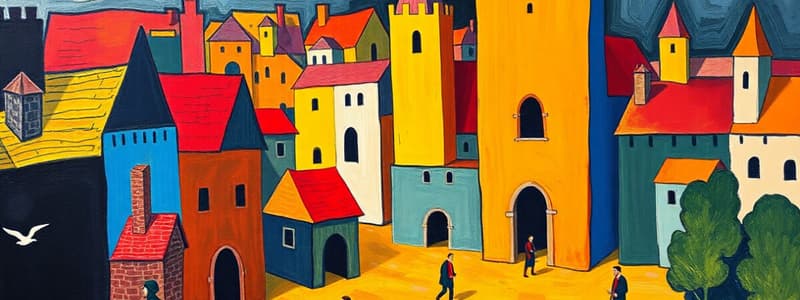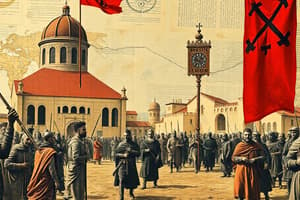Podcast
Questions and Answers
What is the name given to the period between 1000 and 1300 CE?
What is the name given to the period between 1000 and 1300 CE?
The High Middle Ages
What characterized the High Medieval period?
What characterized the High Medieval period?
General revival, the emergence of European nations, and economic, technological, and cultural developments
During the High Middle Ages, the manor farms became less productive.
During the High Middle Ages, the manor farms became less productive.
False (B)
Which of the following factors contributed to the increased food production during the High Middle Ages?
Which of the following factors contributed to the increased food production during the High Middle Ages?
The raids by Vikings and Eastern tribes continued to be a major problem during the High Middle Ages.
The raids by Vikings and Eastern tribes continued to be a major problem during the High Middle Ages.
What were two significant changes that took place in Western Europe during the High Middle Ages?
What were two significant changes that took place in Western Europe during the High Middle Ages?
What were the first towns called in the High Middle Ages?
What were the first towns called in the High Middle Ages?
What were burghs often established near?
What were burghs often established near?
The growth of towns and cities during the High Middle Ages did not lead to increased urbanization.
The growth of towns and cities during the High Middle Ages did not lead to increased urbanization.
What were the different groups that grew within cities and towns during the High Middle Ages?
What were the different groups that grew within cities and towns during the High Middle Ages?
What were guilds?
What were guilds?
Guilds were only controlled by merchants.
Guilds were only controlled by merchants.
What were two main types of guilds?
What were two main types of guilds?
What did traders guilds do?
What did traders guilds do?
Apprentices were always paid for their work.
Apprentices were always paid for their work.
Apprentices could become masters without submitting a sample of their wok to the guild.
Apprentices could become masters without submitting a sample of their wok to the guild.
What were charters?
What were charters?
The growth of towns and cities during the High Middle Ages was solely fueled by the decline of feudalism.
The growth of towns and cities during the High Middle Ages was solely fueled by the decline of feudalism.
What was the economic impact of the growth of towns and cities?
What was the economic impact of the growth of towns and cities?
During the High Middle Ages, knights were rarely paid for their services.
During the High Middle Ages, knights were rarely paid for their services.
What is the name for a person of non-noble birth who gained economic and political influence?
What is the name for a person of non-noble birth who gained economic and political influence?
The growth of towns and cities did not have any negative effects.
The growth of towns and cities did not have any negative effects.
Which of the following were negative effects of the growth of towns?
Which of the following were negative effects of the growth of towns?
Flashcards
High Middle Ages
High Middle Ages
A period of progress and growth in Europe from 1000-1300 CE, marked by the rise of new nations, improved economy and advancements in technology and culture.
Increased Productivity of Manor Farms
Increased Productivity of Manor Farms
The expansion and development of agricultural practices, resulting in higher food production and an increase in population.
Burghs
Burghs
These were the first towns, often established near old Roman cities or strategic trading centers, castles, or abbeys.
Increased Urbanization
Increased Urbanization
Signup and view all the flashcards
Different Groups in Towns and Cities
Different Groups in Towns and Cities
Signup and view all the flashcards
Guilds
Guilds
Signup and view all the flashcards
Traders Guilds
Traders Guilds
Signup and view all the flashcards
Craft Guilds
Craft Guilds
Signup and view all the flashcards
Apprenticeship
Apprenticeship
Signup and view all the flashcards
Charters
Charters
Signup and view all the flashcards
Increased Trade and Use of Money
Increased Trade and Use of Money
Signup and view all the flashcards
Wages and the Rise of the Middle Class
Wages and the Rise of the Middle Class
Signup and view all the flashcards
Negative Effects of Urbanization
Negative Effects of Urbanization
Signup and view all the flashcards
Study Notes
The High Middle Ages (1000-1300 CE)
- The High Medieval Period was a time of revival in Europe, marked by the emergence of nations and significant economic, technological, and cultural advancements.
- Manor farms became highly productive due to increased populations and improved farming technologies. This led to a steady increase in food production.
- Viking and other Eastern tribal raids lessened as Viking tribes converted to Catholicism and other warring tribes adopted the Orthodox faith. Powerful rulers also emerged.
Significant Changes in Western Europe
- Towns and cities began to emerge.
- Feudalism declined and lowered
Emergence of Towns and Cities
- Burghs, the first towns, were established in Flanders, along the coast of Belgium, and northern Italy.
- These often were built around existing Roman towns or developed near key markets/trade centers, castles, or abbeys.
- Increased population led to increased urbanization.
- Cities exhibited diversity—merchants, bankers, artisans, lawyers, doctors, and scholars lived and worked within their boundaries.
Guilds
- Guilds were business associations of merchants and artisans. They had strict rules covering areas like foreign trade, pricing of goods, and wages.
- Masters (artisans owning their own tools and shops) controlled guilds.
- Traders' guilds controlled specific products and activities, while craft guilds ensured quality control in product manufacturing and developed training systems for new artisans.
- Apprentices worked for masters to learn a craft unpaid, becoming journeymen with pay prior to becoming masters after submitting a sample of their work for guild approval.
Emergence of Towns and Cities (Continued)
- Charters guaranteed the rights of townspeople and gave them responsibility for law enforcement and taxation.
- Towns became semi-autonomous political entities.
Growth of Towns and Cities
- Increased trade encouraged the use of money instead of bartering.
- People worked for wages, not shares of farm production.
- Industries boomed.
- The lives of serfs improved.
- Knights also demanded payment for services.
- The middle class (bourgeoisie) gained economic and political influence, though their background wasn't always noble.
Growth of Towns and Cities - Negative Effects
- Buildings were mostly made of wood, increasing the risk of fires.
- Cities were often unsanitary, with garbage and sewage in the streets.
- Unhygienic conditions fostered widespread disease outbreaks like typhoid, influenza, and malaria.
Studying That Suits You
Use AI to generate personalized quizzes and flashcards to suit your learning preferences.





